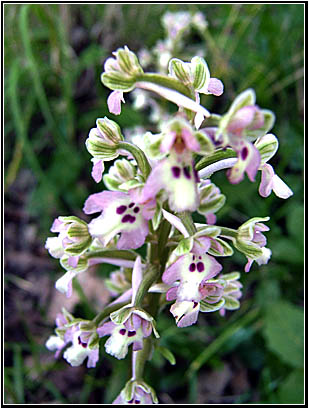|
Orchids
of Israel
|
Dr.
Sara Giladi is curator of Tropical Plantas Conservatory, at
the Jerusalem Botanic Garden, where she has been working for 25
years.
She is graduated in Humanities and took many courses (including
academic), in Botany and Horticulture.
|
|
|
ON: How do you start
to study orchids?
SG: I entered the world of orchids through Marylin
LeDoux, who was the curator in Missouri Botanic Garden, where I was
an intern. She is very professional and we remained good friends.That
was in 1992, when I returned to Israel I devoted myself to orchids.
I started a collection in the Garden, and in 1998 the Israeli Orchid
Society was founded by my initiative.
ON: Could you tell a little about your country? Which are the geographical
conditions on the habitats?
SG: Israel is a tiny country with a very high
number of plant species (2600), in about 20770 sq.km. Its location along
the Jordan Rift on the east side and the Mediterranean Sea on the western
side creates many diverse habitats.
ON: And about the climate?
SG: The precipitation goes from 10 mms in Eilat,
up to 900 mms in the Galilee. The rainy season lasts only 4 months with
low temperatures (-3 degrees Celsius at night, only in the high mountains.
During the day it can go up to 14 degrees).The summer is hot and dry,
28- 35 degrees during the day.
ON: How many genera and species of orchids?
SG: There are 13 Genera with 30 species.
ON: Which are the most important genera?
SG: Orchis and Ophrys are most common,
about 10-13 species each.
ON: Which are the endemic species?
SG: The only endemic species is Orchis israelitica.

Orchis
israelitica |

Orchis
israelitica |
ON: Terrestrial
all they, aren't they?
SG: All orchids in Israel are terrestrial, well
adapted to the Mediterranean climate. They are dormant during the summer,
from May to November, and sprout after the rain.
ON: Which is the biggest dangered orchid in Israel?
SG: There are several orchids that are rare and
endangered, but they are inconspicuous and are located in Protected
Nature Reserves. The most endangered species are Orchis laxiflora
and Epipactis veratrifolia, they are bigger and prettier, and
are threatened by rural and urban development.
ON: What can be done for helping the conservation?
SG: Education to protect Nature and wild plants
has a great impact, but unfortunately it is not efficient enough against
"civilization"
ON: Do you have a kind of government help for this? Is there a preoccupation
about the conservation of orchids or nature in general?
SG: There is a little help from the government
to maintain the Nature Reserves.
ON: Are people concerned about conservation or preservation?
SG: Around my social circle, people are concerned
about conservation, but it's very low % of the whole population.
ON: The number of orchid lover is high?
SG: Today our society has over hundred members
and many more that find this hobby most fascinating but our orchids
compared with yours are small, difficult to find and still almost impossible
to grow. Israeli orchids are not yet grown by us, as they are not accessible
and far from being showy as yours. Friend of mine sowed several native
species, and hopefully they will bloom in few years.
ON: Thank you, Dr. Sara Galadi.
Photos
by Sara Galadi
|
Any
kind of reproduction (print, digital or anyone other) of any
type of material of this site - texts, layout, photos, images
and others - is strictly forbidden without previous written
permission by the authors.
|

|

